Explore the unique experiences to be had while glamping in Greenland, where adventure meets the unpredictability of nature.
I’m sitting in the posh Fröken dining room of Hotel Reykjavik Saga (Lækjargarta 12, 101 Reykjavik. islandshotel.is), slurping a serving of squid ink pasta and getting to know my fellow tour guests when a word I’ve never seen pops up on the welcome slide show: uupaa.
I furrow my brow and do a confused double take before Eddy Savage, one of our expedition leaders from Natural Habitat Adventures, presses pause. “Uupaa is a Greenlandic word that means ‘it’s what you get,’” he explains. “The weather and conditions in Greenland can be really fickle, and even though we’re still going to see a lot, we’re going to have to resign ourselves to the fact that our chartered itinerary probably won’t take place as planned. We’re on Mother Nature’s timeline now.”
This little word quickly became my mantra for the following nine days. It all started with a canceled whale watching trip on day one. Since the weather in southern Iceland was cold, windy, and rainy with low visibility, our guides made a stealthy pivot to view a massive, ashy lava fountain just outside of Reykjavik and hike through The Lava Tunnel (thelavatunnel.is), a craggy underground tube formed long ago by rapidly cooling magma. Both were a fitting end to my three days in Iceland. From there, we took a private coach to the Reykjavik airport to board the once-a-day flight to ultra-remote Kulusuk, Greenland. We prayed that the “uupaa” wouldn’t delay our journey any further.
As a country that’s over three times larger than the state of Texas, with a scant population of 57,000 people, Greenland’s expanse of rock and ice often flies under the radar of western tourists. Remote East Greenland, population 3,500, is even trickier to get to. There’s good news on the horizon, however, for travelers in search of the country’s massive glaciers, unique Arctic wildlife, and Northern Lights viewing opportunities.
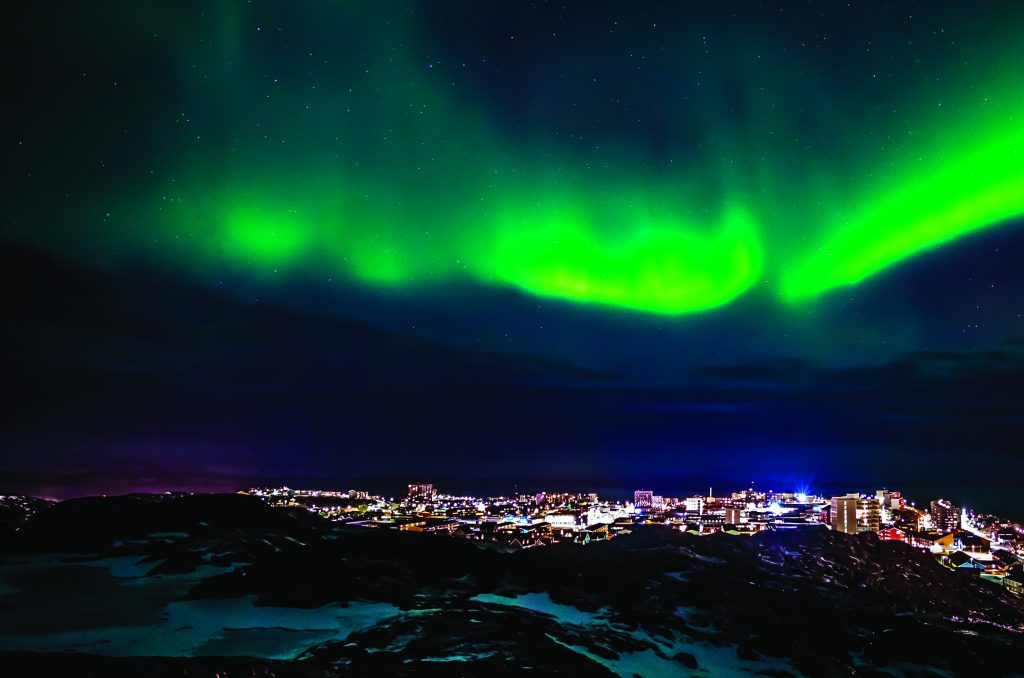
Northern Lights In Nuuk, Greenland (Photo by Vadim N)
There’s good news on the horizon for travelers in search of the country’s massive glaciers, unique Arctic wildlife, and Northern Lights viewing opportunities.
In November 2024, Greenland’s main airport in Nuuk, after being completely revamped, reopened its international terminal, allowing larger transatlantic planes to land in the country for the first time ever. Two additional international runways are expected to be added by 2026, in Ilulissat and Qaqortoq. United Airlines has already announced that it will be adding twice-weekly flights to Nuuk from Newark, New Jersey. Another great way to get to Greenland is with Icelandair, which provides connecting flights from gateways in the USA and around the world.
Thankfully, the travel gods smiled on my group, and after a two-hour flight and a ten minute helicopter transfer, we were on the ground in Tasiilaq, the cultural capital of East Greenland. We promptly checked in at Hotel Angmagssalik (J958+MV9, Tasiilaq, arcticwonder.com/hotel angmagssalik), where, after a piping hot shower, I embraced my newfound mantra and filled up at the on-site buffet dinner. Because of its isolated nature, Greenland can be incredibly hit or miss when it comes to what’s available, food-wise. The food you eat in town is highly dependent on whatever the ships brought in that week. Breakfast might entail scrambled eggs, bacon, and carrots, or eggrolls, while dinner could entail anything from DIY burritos to schnitzel and potato salad. You get what you get.
To be honest, the scenery surrounding Hotel Angmagssalik was so stunning that I would have eaten boiled shoe leather. Brilliantly colored houses freckled the hilly landscape spilling out into the town of Tasiilaq and, beyond that, the steep spires of rocky peaks as far as the eye could see. I fell asleep to the stunning blue twilight of the Arctic and felt ready for adventure.
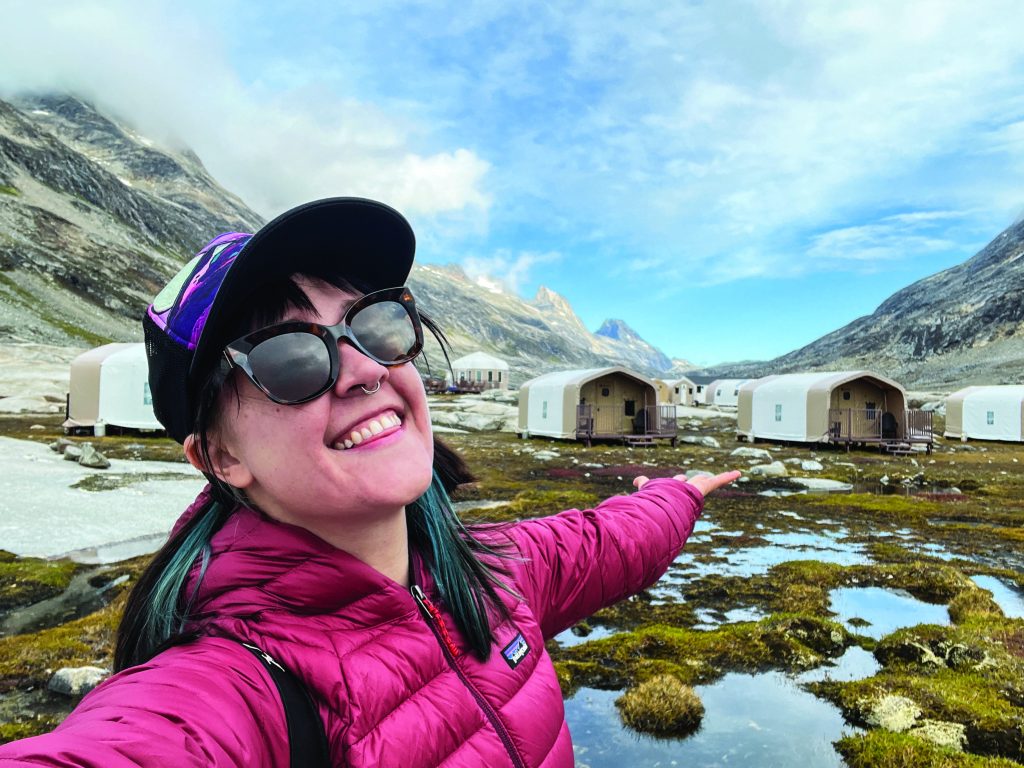
Emily at Greenland Base Camp (Photo by Emily Pennington)
Colby Brokvist, our other Natural Habitat Adventures expedition leader, informed us the next day that “Despite its name, Greenland doesn’t have many green pockets where native plants thrive, and today we’re going to hike up one of them.” After a quick polar bear safety briefing (yes, really), our group set off from the hotel on a two-mile hike up to the Valley of Flowers to photograph the last of the fading bluebells, fuchsia fireweed, and bright yellow hawkweed blooms that carpeted a mountainous inlet just beyond town.
After the hike, Greenland’s notorious bad weather decided to rear its ugly head, and we took shelter in the tiny Ammassalik Museum (Ruttelip Aqq, Tasiilaq, ammassalik.museum.gl). Though its exterior was a modest, century-old church building, its inner wealth of exhibits cannot be downplayed. Historic seal-skin kayaks hung along the walls and photos of Native Greenlanders in traditional garb stood in stark contrast to the town today.
We also saw historic tools, masks, and bone carvings on the main floor of exhibits as Colby walked us through some of the country’s hunter gatherer history. Many of the area’s locals would have lived in sod houses as recently as 70 years ago, but nowadays locals get free education, medical care, and the benefits of Danish citizenship.
That night, dinner was a fantastic display of savory lamb cuts, salad, and roasted potatoes, followed by a how-to photography lecture by Eddy and Colby, both of whom moonlight as professional wildlife and nature photographers when they aren’t guiding. We learned a few important tricks of the trade, from iPhone Northern Lights photo hacks to how to effectively frame icebergs and ragged coastlines. I fell asleep dreaming of our eventual arrival at base camp.
Greenland’s bipolar weather was up to its tricks again, so we spent the morning on a photography-focused tour through town, zooming in on errant icebergs floating in the sapphire bay, and pausing to learn about Cafe Neriu Saaq. This small restaurant, which translates to “Rainbow Café” in East Greenlandic, serves as the main LGBTQ meeting place on this half of the continent. Sadly, it wasn’t open for lunch yet when we strolled by, but Colby explained that it’s run by an amazing trans woman who spearheads a lot of queer-focused activism and community engagement in the area.
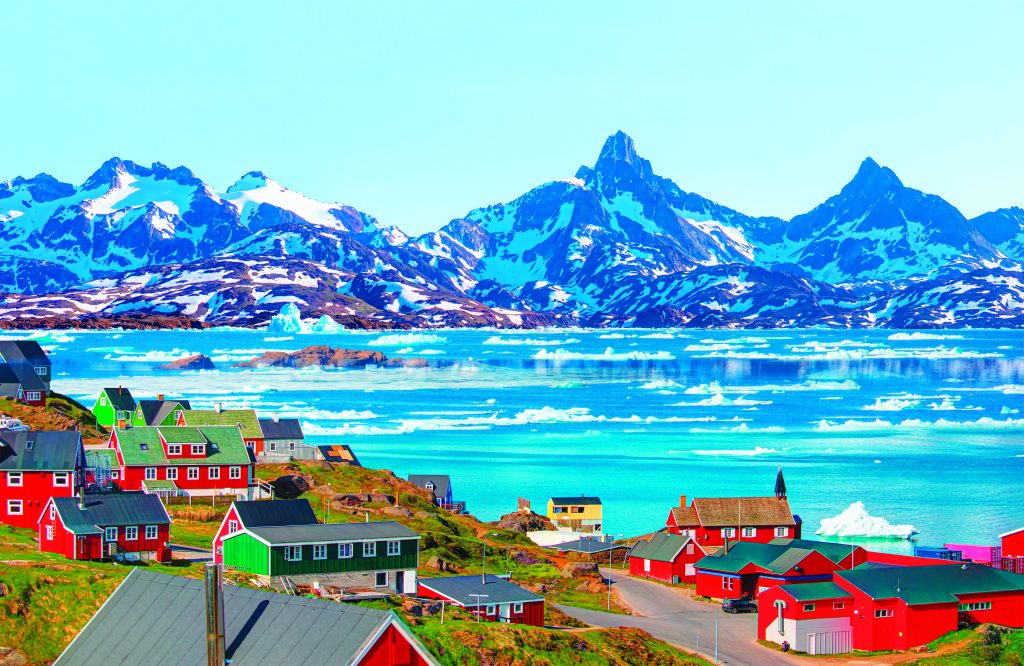
Tasiilaq, East Greenland (Photo by muratart)
As I was pondering the wild notion of campaigning for gay rights in a place as remote as East Greenland, an adorable ball of white floof appeared on the horizon. But this wasn’t a baby polar bear; it was a tiny sled dog puppy, bounding up a grassy hill to greet us. During the winter and spring months, when Tasiilaq’s streets are covered with thick snow, dog sledding still serves as a way for locals to travel from place to place, hunt, and fish efficiently. I spent the remainder of my morning crouching down in the dirt to snap as many ultra-cute photos of the puppies as humanly possible.
The winds were still too rough for us to helicopter transfer into Natural Habitat’s Base Camp Greenland facility, so our clever guides booked a pair of speedboats to brave the choppy waters and get us out and into the Sermilik Fjord. On cue, just as we arrived to the exclusive glamping site that would serve as out home for the next few days, a pair of fin whales began spouting and swimming around the small bay just in front of camp.
Natural Habitat Adventures, which partners with the World Wildlife Fund, prides itself on promoting the utmost in earth-friendly standards in all of its tours. The carbon emissions of my Greenland expedition, for example, were 100% offset by investing in various carbon capture projects around the globe. This commitment to eco-friendliness was evident as we toured camp, from the portable nature of the tents (which get packed away every winter) to the fact that unused food and goods get donated to the nearby village of Tinit at the end of every season.
That being said, Base Camp Greenland is far from a “roughing it” experience. A polar bear-deterring electric fence encircles the camp so that travelers here can roam around at will, day or night. Heated lounge and dining tents with satellite WiFi access serve as communal spaces to hang out and chitchat with fellow tour members, and I’m thrilled to say that there are even hot showers with excellent water pressure in the bathroom tent.
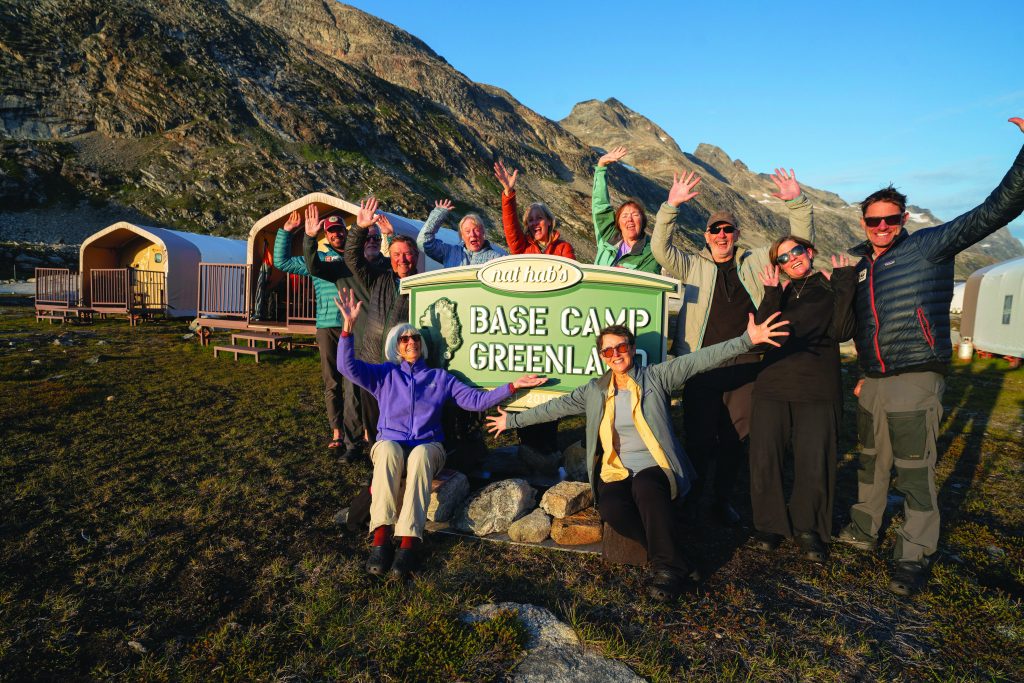
NAT HAB Base Camp Greenland
We rushed through a phenomenal dinner of salmon chimichurri, prepared by resident chef Mary Savage, because our guides had a special treat in store for us. Clear skies meant for epic sunsets in the far north, so Eddy and Colby manned the Zodiac boats and took us out for a sunset iceberg photography cruise. Floating around aquamarine towers of ice against the backdrop of a neon orange sky is an image I’ll not soon forget.
The next morning, I rose to chilly air and sunshine outside. Breakfast was, once again, a fabulous assortment of poached eggs, griddled yams, and fresh fruit (thankfully, Base Camp Greenland is relatively immune from some of the country’s food shipping woes). Because of the incredible weather, our guides proposed a long, active day out in the fjord system.
First up? An otherworldly Zodiac excursion through the area’s sky scraper-sized icebergs. Roughly 80% of the Greenlandic land mass is covered in ice, which, in total, comprises about 10% of the world’s fresh water. Sermilik Fjord, which sits just outside of the protected inlet that houses our base camp, is one of the best places in the world to see them.
We zoomed between glistening hunks of teal ice, pausing to photograph odd shapes and enormous arches. When lunchtime arrived, we pulled onto a rocky beach and waited in the boats while our two guides, armed with rifles, performed a precursory polar bear safety check.
Once we got the all clear, we scrambled up onto a series of nearby boulders to take in the view of barren, charcoal-colored mountains as we ate sandwiches, sipped soup, and gorged ourselves on homemade brownies, courtesy of chef Mary.
As it turned out, this was not a random lunch stop, but a sacred site on which many native sod houses had been built and rebuilt for centuries. Colby led us on a short hike to a collapsing home of stone and mud that was inhabited as recently as the 1970s, explaining the rough life of hunting seals and narwhals and harvesting berries that Green landers endured not so long ago.
I soon learned that uupaa can act as a benevolent force during a trip to Greenland, too, and as we settled in for another delectable dinner at base camp, Eddy explained that conditions looked great for viewing the Northern Lights once the sun had fully set. I set my alarm for 11 P.M., just in case I dozed off, and snuggled into my warm tent to read until it was time.
“The Northern Lights are in the sky,” exclaimed Colby like a human alarm bell as he paraded around camp in the dark of night. I leapt out of bed, bundled up, and craned my neck skyward. Sure enough, a faint, undulating ribbon of light hung in the sky above our tents, cradled by the surrounding black of mountains.
During each of the following days at base camp, our guides would double check the weather forecast, poke their heads out of their tents each morning in case it was wrong, then make a plan for the adventures we’d embark on that day. We spent a cloudy morning kayaking to an island inhabited by locally-owned Greenlandic sled dog puppies that hopped and yelped each time our boats approached. We hiked through tussocks and dense tundra plants in a glacially-carved valley bordered by dark, foreboding peaks, and we rambled through vibrant yellow flowers in search of more sod houses.
Many of my favorite experiences in East Greenland were the human connections we got to make with its locals. After all, in an increasingly modern world, it’s rare to have the privilege of visiting a country whose population is largely indigenous. They say that America is a nation of immigrants, but Greenland, it seemed, was a place of longstanding tradition and deeply-rooted culture. This feeling was evident in each place we visited. On our last full day at base camp, we visited the nearby village of Tinit, population 56, to meet up with Mathias Bianco and his girlfriend to learn about traditional Greenlandic hunting and clothing. After a short town tour, which involved a trip to what is likely the smallest grocery store I will ever witness, Mathias led us into his home, where his girlfriend displayed a gorgeous assortment of garments that she and her family had handcrafted with beads, embroidery, and seal skin.
As we returned to camp, our crew had one last surprise for us before dinner. Max Audibert, a French man who’d relocated to Tinit decades ago, kayaked the three miles from town to show off his traditional, handmade kayak and perform a series of underwater rolls in it. Our entire group whooped and cheered for him as he performed his incredible stunts in the frigid water. Afterwards, he joined us for yet another mouth-watering dinner of roast beef tenderloin, kale Caesar salad, and raspberry chocolate cake for dessert.
One morning at camp, we meandered across the tundra and along a creek, picking wild blueberries and taking pictures of the snow-dusted peaks as we strolled. Eddy had us pause in silent meditation for a full ten minutes to take in the utter majesty of the place, miles from civilization of any kind. But then, Uupaa pre vailed yet again.
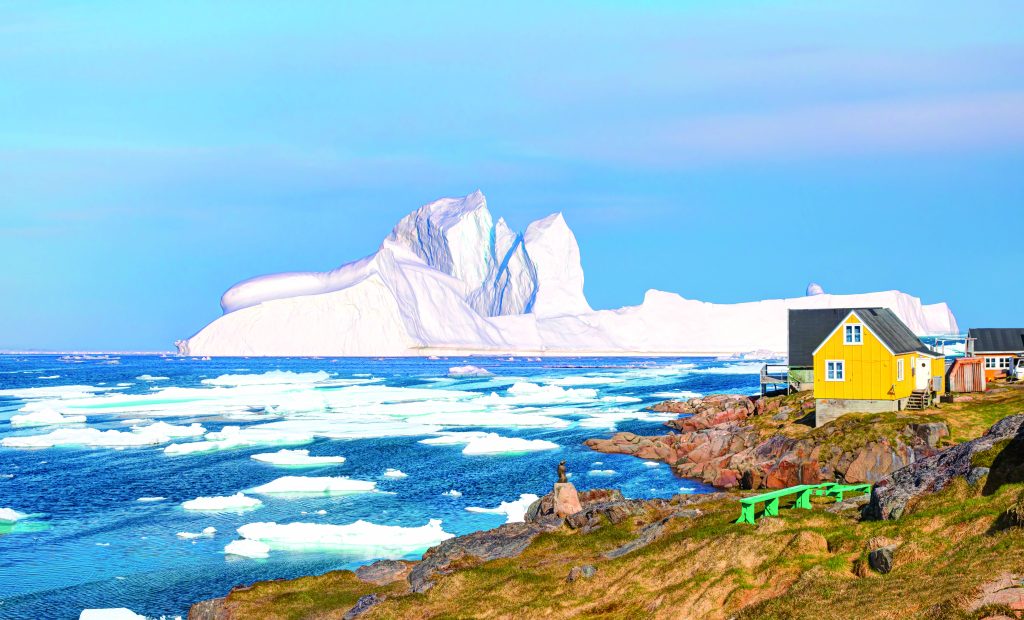
Iceberg Near Kulusuk Village in East Greenland (Photo by Muratart)
The helicopter transfer from camp could seat up to ten people safely, and after the first one left with the rest of the guests, Colby and I got left behind, shifting gears to a boat transfer once low-hanging clouds closed in. C’est la vie. We made it to Hotel Kulusuk (B-1500, Kulusuk, arcticwonder.com/hotel-kulusuk) just in time to scarf down a late dinner, charge our phones, and pass out.
To cap off the trip the next morning, we went on a glacier hike near town. I stood awestruck on the deck of the boat as a pair of humpback whales surfaced again and again, feeding near a cluster of petite islands. At the foot of the glacier, we strapped knife-like crampons to our boots and trekked uphill for a quarter mile before taking a sharp left turn into a cerulean blue ice cave. My jaw practically fell to the floor as we were led inside, and I smoothed my fingers along its glassy walls.
I took a deep breath in the stillness of that ice cave at the edge of the earth, feeling the most at peace that I had in a long time. The nature of the cavern was ephemeral, our guides explained, and it likely wouldn’t even exist in another two years. I found some strange solace in that. Nature, no matter how powerful, is an ever shifting current.
Regardless of what stress I might feel during the long journey back home, my week of practicing the Greenlandic mantra of “uupaa” had stilled my spirit. Compared to the city-based stressors that I’m often wrapped up in, I felt as calm as a Buddhist monk, a sentiment I carried with me for weeks after the trip.
Too busy with work? Uupaa. Rain forecasted during that Friday night concert? Uupaa. “It’s what you get.”


